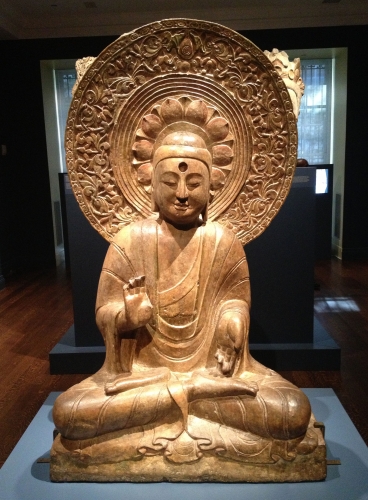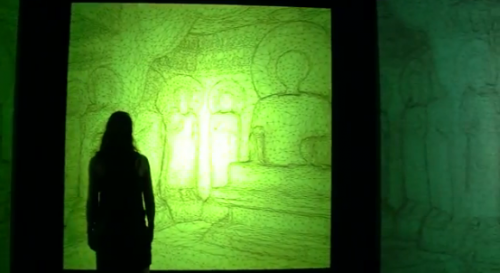The great Buddhist reliquaries of the world—be they caves, mountainside monasteries, summit stupas, or ancient monuments—remain inaccessible to most due to their remoteness. Though great leaps in transportation technology have closed vast distances, both the pillaging of artifacts and the limiting of exposure in the interest of preservation continue to make visits to these far-flung sites difficult.
Two alternatives act as windows that provide virtual access to these otherwise inaccessible environs: the removal of objects of worship into private collections and museums, whereby they can be admired by the privileged elite and the general public, respectively, or the creation of immaterial or easily transportable renderings—primarily photography, but also painting and, more recently, digital modeling.

A new exhibit at New York University’s Institute for the Study of the Ancient World, Echoes of the Past: The Buddhist Cave Temples of Xiangtangshan, implements both of these methods, bringing to life the masterfully sculpted buddhas of the cave temples within a digital recreation of their original context. The collection, consisting of large, imposing sculptures from the Northern Qi period (550-577 CE), is complemented by a cutting-edge, human-scale 3-D reconstruction of the cave’s interior in an adjacent room.
The name Xiangtangshan translates as “Mountain of Echoing Halls,” referring to two groups of rock-cut shrines that stand as the crowning cultural achievement of the short-lived Northern Qi dynasty. Non-Chinese emperors and courtiers from north of the Great Wall who practiced Buddhism—a religion favored by this elite—commissioned the cave temples. The effigies found in the caves, which were looted and circulated in the international market, remain some of the finest examples of Chinese Buddhist sculpture.
The University of Chicago and the Smithsonian Institution have reclaimed many of the artifacts of the cave temples and brought them together again under one roof—and (digital) cave ceiling—in the exhibit currently being shown on Manhattan’s Upper East Side. In the digital recreation, the complete sculptures rediscover their cavernous context and the itinerant appendages reattach to the enlightened being to which they once belonged. The result is an integrative, immersive experience of the effigies in their original setting.
The sculptures taken alone make a magnificent impression in their scale and heft. Perhaps the most impressive are the fragments: those dismembered torsos, free-floating hands, and arresting, pedestalled buddha-heads. Many of these once belonged to 20-foot-tall buddhas of the northern cave, the most spacious and resplendent of the series of cave temples in Xiangtangshan. Imagining, with the help of the digital reconstruction, the intact statues to which these pieces once belonged takes one aback. These may have been objects of worship in and of themselves, but the large cave that housed them en masse was surely a place of worship, inspiring awe much like the tall, vaulted ceilings of Europe’s greatest cathedrals.
The skillfully crafted pieces demonstrate an extraordinary attention to detail. Most pieces consist of carefully demarcated detailed areas, such as a felicitously draped robe or an ornate headpiece, as well as incredibly simple, well-shaped components, on which the artist exhibited great restraint. The overall effect is one of wholeness. It is this skill in craftsmanship that likely led to its own downfall—the depredation of the cave temple.
Functioning so convincingly as standalone pieces, the statues would fetch favorable sums in the auction houses of Paris, London, New York, and Tokyo beginning in the early 1900s. Like other regions that currently source the Buddhist art trade, such as Afghanistan, Pakistan, and Nepal, China was plagued by its own local looters, who introduced the artifacts of the Xiangtangshan cave temples into the international market.
The full-scale 3-D reconstruction of the cave is the product of the combination of a variety of sources. Research teams from the University of Chicago and Peking University collected black-and-white photographs from the 1920s, new color photography, and 3-D laser scans of the cave’s interior and its scattered sculptures. Using texture-mapping, the surfaces of the 3-D models were overlaid with color photographs of the corresponding areas.

The digital recreation is projected on a series of three large screens that form a semi-circle around the viewer. Combining still and moving images, the camera’s eye guides the viewer through the elaborate Xiangtangshan caves. The video does not, however, give any sense of scale. The best way to explore the exhibit, then, is to begin by perusing the effigies and finish the visit with the digital cave.
Recontextualized in the digital cave, those huge dismembered hands from the adjacent room endow the digital cave with a sense of size—not to mention an otherwise absent sense of realness. The two facets of the exhibit, the effigies and the digital cave, complement one another beautifully, each reinforcing the strengths of the other. The two, however, are not equal. While the sculptures hold up well on their own, the digital cave, taken alone, remains underwhelming.
This indicates the limits of such technology, which we can expect to see more and more of in museums around the world. Though digital recreation provides a context for artifacts, it cannot substitute substance. In addition—and this is of the utmost significance—it cannot substitute that which is most elusive and insubstantial about any piece of art: its aura. Aura takes on all the more importance in regard to objects and places of religious worship, as it is precisely this aura that bridges the material to the numinous. Though it cannot be attributed to the object or the mind alone, it is precisely what renders the object and, potentially, its environs, worthy of worship.
Echoes of the Past establishes digital recreation as an indispensable tool in the future of archaeology and museography, but not for religious worship or pilgrimage. It might, however, be too soon to dismiss it for such uses. Perhaps, when virtual reality technology is up to snuff, we’ll find ourselves laying virtual gold leaf on virtual buddha statues in an environment no more illusory than that one we call reality.
Echoes of the Past: The Buddhist Cave Temples of Xiangtangshan can be viewed through January 6 at the Institute for the Study of the Ancient World, 15 E 84 St, New York, NY. Find more information here.